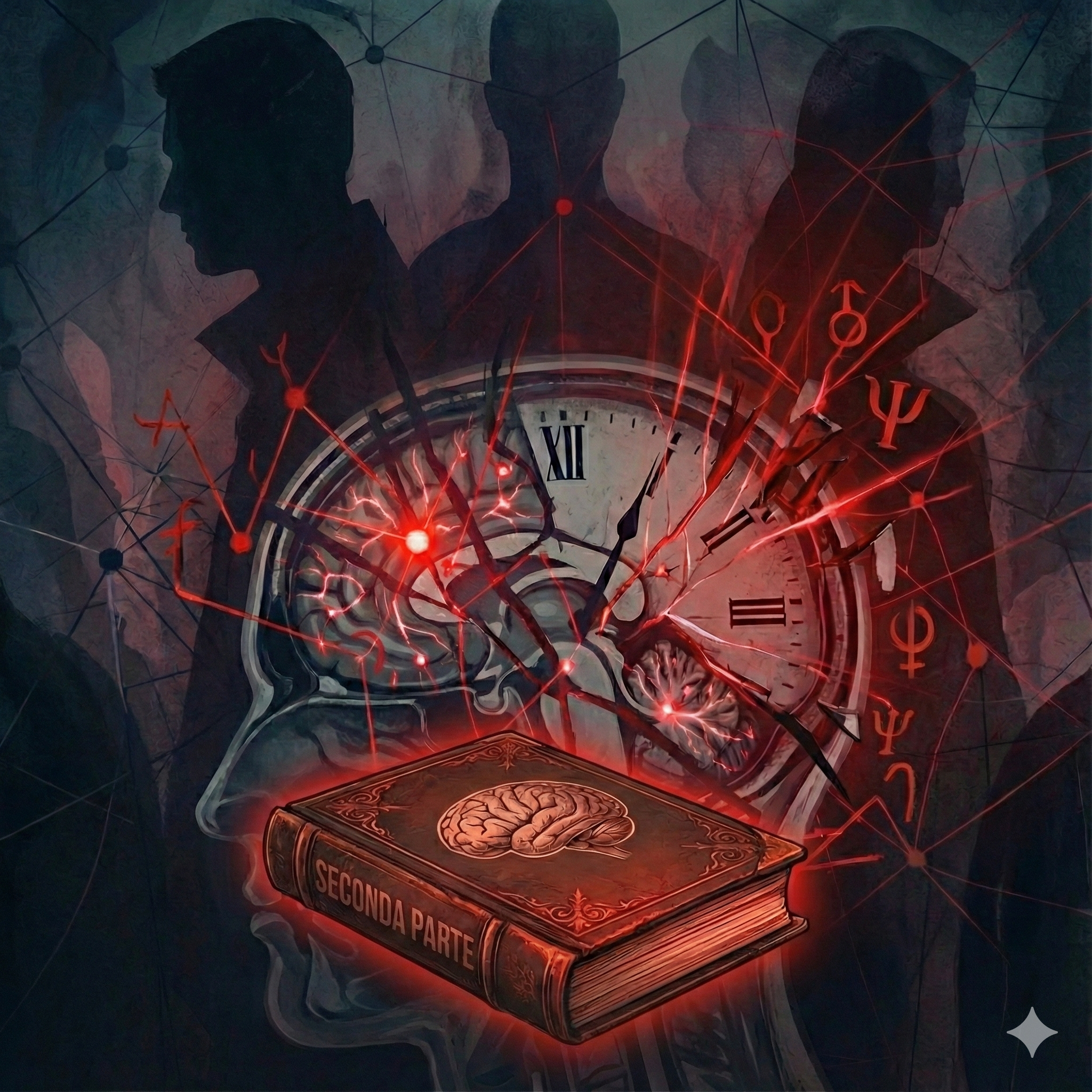The neural footprint of relational trauma: a neuroscientific re-reading through the model of italian psychotraumatology
Authors: Massimo Lattanzi¹²³ & Tiziana Calzone¹²³ ¹ Italian Association of Psychology and Criminology (AIPC) ² Italian Center for Relational Psychotraumatology (CIPR) ³ National Observatory on Familial Homicides (ONOF)
Abstract
This paper aims to integrate recent discoveries in the field of brain connectivity neuroscience with the theoretical-clinical models of Italian relational psychotraumatology. Starting from a critical analysis of a significant neuroscientific study (Tsomokos, Rakesh et al., Psychological Medicine) that identifies specific alterations in the connectivity of the Default Mode Network (DMN) and the Frontoparietal Network (FPN) in adolescents exposed to social threat, this article reinterprets this data as the neurobiological signature of attachment trauma. We argue that the reduced internal connectivity of the DMN corresponds to the fragmentation of the Self and structural dissociation, while the weakening of the FPN underlies chronic emotional dysregulation. The anomalous hyper-connection between the DMN and external attention networks is presented as the neural correlate of hypervigilance and toxic shame. These neural patterns, considered as a whole, outline the architecture of a "traumatized brain" which, incapable of self-regulation, is driven to re-enact childhood traumatic dynamics in adult relationships. The concepts of the "Partner Paradox" and the "Traumatic Bubble" are discussed as relational outcomes of this neural footprint. Finally, the clinical implications of this integrated model are outlined, emphasizing the need for bifocal ("top-down" and "bottom-up") therapeutic interventions aimed at restoring self-regulation capacities and promoting Self-integration.
1. Introduction: The neurobiological grammar of relational trauma
Contemporary psychotraumatology has made a fundamental distinction between "Big T" traumas (single events that threaten physical integrity) and "little t" traumas (adverse and cumulative relational experiences that threaten the integrity of the Self). It is in the domain of relational trauma that the most complex psychopathology is rooted. The Italian psychotraumatology model posits that the most pernicious trauma is not the adverse event itself, but its occurrence at the hands of an attachment figure, generating an unsolvable biological paradox. As theorized by Giovanni Liotti, the child finds themselves trapped between two innate motivational systems: attachment, which pushes for proximity, and defense, which mandates escape from the very figure who is the source of terror.
The adaptive solution to this paradox is dissociation, a fracture in the integration processes that leads to the compartmentalization of experience into "me" and "not-me" self-states. This "grammar of trauma" is not a metaphor, but a true neurobiological algorithm that programs the rules for threat perception and affective regulation. Neuroscience confirms that such experiences alter the architecture of neural circuits, shifting the focus from a "lesion" model to one of "altered development": the brain doesn't have a trauma, it becomes a traumatic brain. A recent study on brain connectivity in adolescents who perceive their environment as dangerous offers an unprecedented opportunity to visualize this algorithm in action.
2. Analysis of the Reference Neuroscientific Study
The study by Tsomokos, Rakesh, and colleagues examined a sample of nearly 8,700 adolescents, correlating the perception of social threat (at home, at school, in the neighborhood) at age 10 with specific resting-state brain connectivity patterns. From our perspective, "perceived social threat" is the direct measure of the chronic and unresolved activation of the attachment system in an insecure context, the core of developmental trauma.
The results highlighted two main alterations:
- Reduced within-network connectivity: Weakened internal communication within the Default Mode Network (DMN), associated with self-referential thought, and the Frontoparietal Network (FPN), implicated in executive control.
- Increased between-network connectivity: Greater communication between normally separate networks, particularly between the DMN and the Dorsal Attention Network (DAN), which is oriented toward external monitoring.
These changes, which predict the development of subsequent internalizing problems (anxiety, depression), support a model in which the neural footprint of trauma precedes and mediates the psychopathological outcome. It also emerged that, although family conflict was the strongest predictor of future pathology, it was neighborhood insecurity that associated most strongly with the neural alterations. We interpret this as a two-step process: family conflict writes the code for neurobiological vulnerability, while chronic environmental threat executes and solidifies that code, making it a stable and measurable connectivity pattern.
3. Discussion: Mapping Between Neurobiological data and psychotraumatological constructs
The integrated analysis of neuroscientific data and the principles of relational psychotraumatology allows for the construction of a coherent mapping between the two domains.
3.1. The DMN and the fragmented self
The DMN is the neural infrastructure of the narrative and cohesive Self. Its reduced internal connectivity, observed in youth exposed to threat, is the neurobiological signature of a non-integrated Self, the physical counterpart of structural dissociation. A DMN whose components communicate inefficiently is a brain that struggles to build a unified self-image, the biological basis for the coexistence of "me" and "not-me" parts. This disconnection explains the deficits in autobiographical memory and mentalization, hallmarks of complex trauma.
The most revealing aspect, however, is the hyper-connection between the DMN (Self) and the DAN (external threat). This anomalous fusion is the neural mechanism underlying toxic shame. In a traumatized brain, every act of self-reflection ("who am I?") is inseparable from monitoring danger ("am I in danger?"), merging identity with threat. The caregiver's failure is internalized as proof of one's own unworthiness ("it's my fault"), creating an indelible association between identity and danger.
3.2. The FPN and the architecture of chronic insecurity
The reduced internal connectivity in the FPN, a system crucial for top-down emotion regulation, is the neural basis of emotional dysregulation and impulsivity. An inefficient executive control system fails to modulate subcortical alarm responses, leaving the individual at the mercy of intense and uncontrolled emotional reactions. This "less distinct" brain organization reflects a nervous system that has lost flexibility, stuck in a state of hypervigilance and/or dissociative collapse, as described by Polyvagal Theory. This picture corresponds to our description of the "traumatized brain": a system that has lost the ability to distinguish between safety and danger, becoming fixed in a defensive operational mode.
3.3. From childhood disorganization to the adult "traumatic bubble"
The described neural architecture—fragmented Self, regulation deficits, and chronic hypervigilance—defines what we call the "co-dependent brain." Incapable of self-regulation, this brain is compulsively driven to seek an "external regulator" to manage distress. This drive guides partner choice according to the "Partner Paradox": the unconscious search not for a "healthy" partner, but for one whose "complementary wound" resonates with one's own traumatic architecture.
The resulting dyadic system is the "Traumatic Bubble," an isolated and self-referential couple space that functions as a "trauma echo-chamber." The partners use each other as regulatory prostheses, but in a way that continuously reactivates the threat circuits. The bubble offers a predictability that, however painful, is neurobiologically less costly than chaos. It functions as a "traumatic thermostat" that keeps the system in a toxic but familiar zone, explaining the profound resistance to change.
3.4. Integration of neuroscientific findings and psychotraumatological constructs
The integration of neuroscientific discoveries and clinical models allows for direct mapping. A first finding is the reduced internal connectivity in the Default Mode Network (DMN). This alteration, interpreted as an impairment of self-referential processes, constitutes the neural basis for a fragmented Self and dissociation, and is associated with concepts such as structural dissociation, "me/not-me" self-states, and mentalization deficit.
Similarly, the reduced internal connectivity in the Frontoparietal Network (FPN) corresponds to a deficit in executive functions, the basis of emotional dysregulation and impulsivity. A third crucial finding is the increased connectivity between the DMN and the Dorsal Attention Network (DAN). This anomaly reflects a state of chronic hypervigilance and the fusion of identity and threat, the foundation of toxic shame and the "traumatized brain."
Finally, the fact that these neural alterations are predictive of future symptoms supports the model that the neurobiological footprint of trauma is the vulnerability for its re-enactment. This is where integrated concepts such as C-PTSD, the "Traumatic Bubble," and the "Co-dependent Brain" are situated.
4. Conclusions and clinical implications
The integration of neuroscientific discoveries and the Italian relational psychotraumatology model outlines a causal chain from attachment trauma to the neural footprint and its re-enactment in adult relationships. This offers empirical validation for the clinical constructs developed by our working group (AIPC, CIPR).
The implications for clinical practice are profound:
- Need for a bifocal approach: An integrated intervention is essential, acting in a "top-down" manner (working on narrative and mentalization) and "bottom-up" (aiming at nervous system regulation through techniques like biofeedback, EMDR, and somatic approaches).
- Therapeutic goal: "bursting the bubble": The primary objective is to help partners shift from dependence on a dysfunctional "external regulator" to developing individual self-regulation capabilities. Neurobiologically, this means strengthening the internal connectivity of each individual's FPN and DMN.
- The Role of the therapist: The therapist acts as a "healthy external regulator" and a surrogate "secure base." Through a secure therapeutic relationship, they offer the patient's nervous system new intersubjective experiences capable of renegotiating dysfunctional neural patterns, promoting Self-integration, and opening the way to a relational life no longer governed by the grammar of trauma, but by the possibility of healing.
Selected bibliography on relational psychotraumatology
The following bibliography focuses on the works that found and elaborate upon the relational psychotraumatology model described in the article, with a focus on Italian contributions.
Foundational Works and Theoretical Contributions
This section includes the works that laid the groundwork for understanding attachment trauma and dissociation.
- Liotti, G. (1992). Disorganized/Disoriented attachment in the etiology of dissociative disorders. Dissociation, 5, 196-204.
- This article is one of the first seminal works in which Liotti directly links disorganized attachment observed in childhood with the development of dissociative disorders in adulthood, a central concept in the article.
- Liotti, G., & Farina, B. (2011). Sviluppi traumatici. Eziopatogenesi, clinica e terapia della dimensione dissociativa. Raffaello Cortina Editore.
- A foundational work that systematizes Liotti's thought on trauma, dissociation, and their clinical implications, offering a comprehensive framework of attachment theory from a developmental-traumatic perspective.
- van der Hart, O., Nijenhuis, E. R., & Steele, K. (2006). Fantasmi nel sé. Trauma e trattamento della dissociazione strutturale. Raffaello Cortina Editore. (Original: The Haunted Self: Structural Dissociation and the Treatment of Chronic Traumatization).
- Although not directly cited, this text is crucial for understanding the theory of structural dissociation of the personality ("me" and "not-me" parts) to which the article refers.
Contributions by Lattanzi and Calzone (AIPC/CIPR)
This section lists articles and publications that develop the clinical models of the "co-dependent brain," the "Partner Paradox," and the "Traumatic Bubble."
- Lattanzi, M., & Calzone, T. Various Articles on the "Traumatic Bubble" and "Partner Paradox." Published on www.associazioneitalianadipsicologiaecriminologia.it.
- Description: Through numerous articles and reports, Lattanzi and Calzone have introduced and developed the models of the "Traumatic Bubble" as a trauma echo-chamber in the couple and the "Partner Paradox" as a re-enactment of Liotti's caregiver paradox in adulthood. These writings, available on the AIPC website, represent the primary source for understanding these constructs.
- AIPC Publishing. Publications and Conference Proceedings on Trauma and Violence.
- Description: AIPC's publishing activity includes the publication of ebooks, seminar summaries (e.g., "Trauma and Violence"), and books (e.g., "White Chairs") that collect the outcomes of clinical research and interventions by the CIPR and ONOF working group, often edited by Lattanzi and Calzone.
- CIPR (Italian Center for Relational Psychotraumatology). Webinars and Training Materials.
- Description: CIPR disseminates its model through training events, such as webinars on relational psychotraumatology, which illustrate the neurobiological (e.g., Polyvagal Theory) and clinical foundations of their approach to complex trauma.
Articles and online resources (from the AIPC website)
The Italian Association of Psychology and Criminology website serves as the main archive for the research group's work.
- Lattanzi, M., & Calzone, T. (2025). La bolla traumatica e il paradosso del partner di Lattanzi e Calzone, la riattualizzazione del trauma nella coppia. Associazione Italiana di Psicologia e Criminologia.
- This specific article, cited in search results, is a key example of how the concepts are articulated and presented to a professional audience, directly linking childhood trauma to adult couple dynamics.
- Calzone, T., Ventura, C., & Lattanzi, M. Weekly Reports of the National Observatory on Familial Homicides (ONOF). Associazione Italiana di Psicologia e Criminologia.
- The ONOF reports, such as the one on "Partnericide," apply the relational psychotraumatology model to the analysis of real cases of violence, providing data and clinical interpretations that substantiate the theory of attachment trauma as the matrix of violence.
- AIPC/CIPR. (2025). Psicotraumatologia relazionale: il ciclo della violenza. Settimana del Cervello 2025. Associazione Italiana di Psicologia e Criminologia.
- Article summarizing the interventions and concepts presented during science communication events (e.g., Brain Awareness Week 2025), showing the commitment to connecting neuroscience discoveries with clinical practice.



